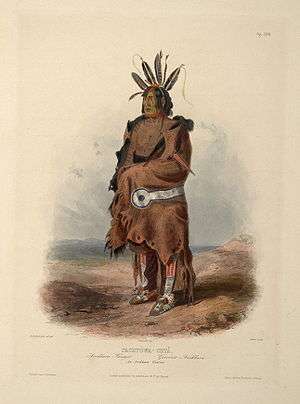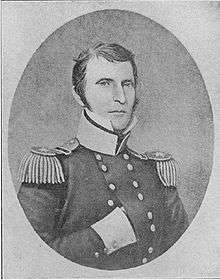Arikara War
| Arikara War | |||||||
|---|---|---|---|---|---|---|---|
| Part of the American Indian Wars | |||||||
 An Arikara warrior, by artist Karl Bodmer | |||||||
| |||||||
| Belligerents | |||||||
|
United States Sioux | Arikara | ||||||
| Commanders and leaders | |||||||
|
William Ashley Joshua Pilcher | unknown | ||||||
| Units involved | |||||||
Missouri Legion[2]
|
Arikara
| ||||||
| Casualties and losses | |||||||
| 12 members of Ahsley's company killed[1] | unknown | ||||||
The Arikara War was an armed conflict between the United States and Arikara Native Americans that took place in the summer of 1823, along the Missouri River in present-day South Dakota.[3]
History
When Lewis and Clark reached Arikara settlements in 1804, the inhabitants did not show hostility to the expedition. In 1805, during a trip to the United States capital, an Arikara leader died, and many Arikara believed that Americans were involved in his death. Later, as a result of the growing activity of fur trading companies, contact between Arikara and white merchants became more frequent, and skirmishes eventually followed.
On 2 June 1823,[4] Arikara warriors assaulted trappers working for General William Henry Ashley's Rocky Mountain Fur Company on the Missouri River, killing about 15 people. This attack is depicted in the 2015 film The Revenant. The surviving trappers retreated down the river and hid in shelters, where they stayed for more than a month. The United States responded with a combined force of 230 soldiers of the 6th Infantry, 750 Sioux allies, and 50 trappers and other company employees[5] under the command of Lieutenant Colonel Henry Leavenworth.[3]
Leavenworth arrived at the Arikara village on 9 August and commenced the attack using his Sioux cavalry, but this was held off by the Arikara. On 10 August Leavenworth ordered an artillery bombardment. This was largely ineffective, the shots falling beyond the village, so Leavenworth then ordered an infantry attack. Like the Sioux auxiliaries, the regular infantry also failed to break into the village. On 11 August Leavenworth negotiated a peace treaty, but fearing further attacks, the Arikara left the village that night. Leavenworth set off to return to Fort Atkinson on 15 August. The Arikara village was burned behind him.[4]
The causes of the war are not well recorded, but the trading relationship of the Arikara with white traders was certainly a factor. The Arikara lived in permanent settlements for most of the year where they farmed and fished. However, this was insufficient to sustain them and they relied on being a center of trade with neighboring tribes to survive. Ashley's expedition to directly acquire furs and pelts cut out the Arikara in their role as trading middle-men and was thus a direct threat to their livelihood. There was also the issue of their desire to have a trading post on their territory so that they could have easy access to manufactured goods. They resented the fact that their long-time enemies, the Sioux, had such posts, but they did not. Ashley had been asked to set up a trading post when he was in the area in 1822. Not wishing to limit his operations by having to maintain a permanent base, Ashley instead promised the Arikara that he would have the goods they asked for shipped to them directly from St. Louis. Ashley had not made good this promise at the time of his 1823 expedition, and possibly never intended to.[6] A further source of resentment, although probably not a direct cause of the war, was the death of the Arikara chief Ankedoucharo during a visit to Washington in 1806. Ankedoucharo died of natural causes, but it was widely believed among the Arikara that he was deliberately murdered.[7]
Although brief, the conflict was noted for two reasons. First, it was the first military conflict between the United States and Native Americans in the West, setting the tone for future encounters between whites and other Native American groups, including the Crow and Blackfeet. Second, Leavenworth did not completely defeat the Arikara; his leniency toward them sparked a great debate between white Americans demanding subjugation of the natives and those advocating for peaceful cohabitation.
The Arikara eventually settled with the Mandan and Hidatsa on the Fort Berthold Reservation in North Dakota. Many Arikara and Crow people became Indian scouts during the height of the Sioux Wars.
References
- 1 2 3 History.com "Ashley’s fur trappers attacked by Indians"
- ↑ Backdrop for Disaster: Causes of the Arikara WAr of 1823 by Roger L. Nichols
- 1 2 Marley, David (1998). Wars of the Americas: a chronology of armed conflict in the New World, 1492 to the present. ABC-CLIO. pp. 464–465. ISBN 978-0-87436-837-6.
- 1 2 Nichols, p. 143
- ↑ James A. Crutchfield, Candy Moutlon, Terry Del Bene, The Settlement of America: An Encyclopedia of Westward Expansion from Jamestown to the Closing of the Frontier, p. 62, Routledge, 2015 ISBN 1317454618.
- ↑ Nichols, pp. 149-150
- ↑ Nichols, p. 147
- Roger L. Nichols, The American Indian: Past and Present, University of Oklahoma Press, 2014 ISBN 0806186143.
Further reading
- Roger L. Nichols. Warrior Nations: The United States and Indian Peoples. Norman, OK: University of Oklahoma Press, 2013.
- Nester, William R. The Arikara War: The first Plains Indian war, 1823. — Mountain Press Publishing Company, 2001. — 257 p.
